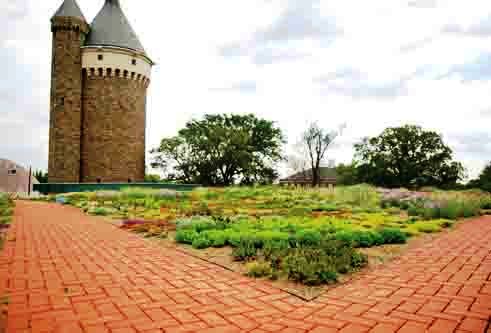‘Green Infrastructure’ to Reduce Tunnel Plans

By Cuneyt DilCurrent Correspondent
D.C. has a new solution for stormwater runoff and the area’s polluted waterways: hundreds of acres of new green roofs, rain gardens, tree boxes, porous asphalt and other eco-friendly measures, collectively known as “green infrastructure.”
Mayor Muriel Bowser and officials from the D.C. Water and Sewer Authority (known as DC Water), the U.S. Environmental Protection Agency and the U.S. Justice Department joined together last week on top of the Fort Reno Reservoir, in front of an acre of green roof plants and pervious pavement, to announce the city’s new plan to combat sewage overflow.
Instead of building new tunnels in Rock Creek and alongside the Georgetown waterfront, a swath of water-capturing green infrastructure similar to what is used at Fort Reno will be constructed from Howard University to Takoma, and also around Burleith and Georgetown. In total, the plan envisions enough green infrastructure in these areas to offset the amount of runoff that results from 1.2 inches of rain falling on 500 impervious acres.
The plan still relies on “gray infrastructure,” with the planned construction of a 30-million-gallon tunnel along the Potomac River, which will run south to connect with the under-construction Anacostia River Tunnel System and end up at the Blue Plains Advanced Wastewater Treatment Plant.
But with the new green infrastructure, that tunnel will need to hold 18 million gallons less wastewater than the originally planned version running from the Kennedy Center to the Key Bridge, which would have had the capacity to store 58 million gallons. And authorities are entirely discarding the original plan for a new sewage tunnel to divert wastewater from Piney Branch in Rock Creek.
The announcement of the new plan, on May 20, comes after the District was able to modify the $2.6 billion Clean Rivers Project, a 2005 agreement with federal authorities that mandated that the city improve its waterways. Reducing the amount of untreated sewage that ends up in rivers after heavy rains is a large portion of the agency’s commitment. Hawkins said the modified plan will achieve equal or better results as the previous tunnel plan, in addition to creating environmental benefits from the added greenery in the city.
Under the District’s combined sewer system — which was constructed in the late 19th century and continues to serve much of the city — sanitary sewage and stormwater go into the same pipes. With heavy rain, runoff water collects trash and debris from streets and ends up in the sewers at a faster rate than the system can handle. The stormwater, mixed with sewage, then ends up spilling into the river or flooding streets.
With the alternative solution, green roofs and permeable pavements will catch the rain before it runs off, saving the sewer system from having to hold excess wastewater.
“Just earlier this week we had two and a half inches of rain in a 12-hour period that went flooding throughout the city,” DC Water general manager George Hawkins said at the plan’s announcement.
Bowser is on board with the revised plan after reaching an agreement with Hawkins for hiring city residents to fill over half of the new jobs created by the green infrastructure project.
“We know this is an innovative step; it is a bold step,” said Bowser. “It is also not an easy step, but it is one we will put all of our minds to and get D.C. residents back to work.”
John Cruden, assistant attorney general of the Justice Department’s Environment and Natural Resources Division, praised city leaders for the environmental and employment opportunities the deal is meant to create.
“What you’re seeing here today puts the District of Columbia in a leadership role in green infrastructure in the nation,” Cruden said. “It is true you can have environmental progress, and you can grow middle-class values, … but it requires the kind of leadership you’re seeing today.”
